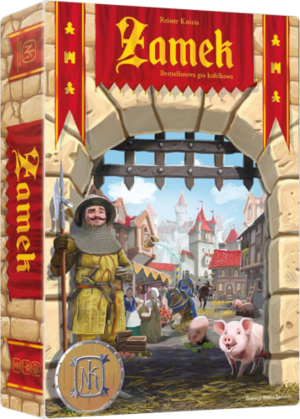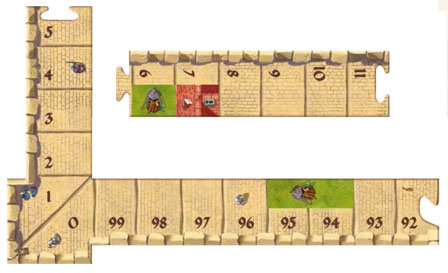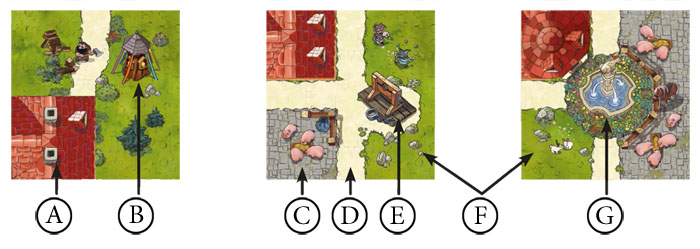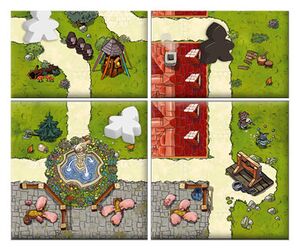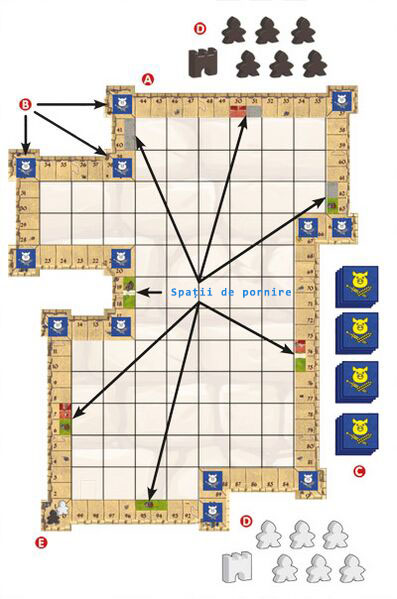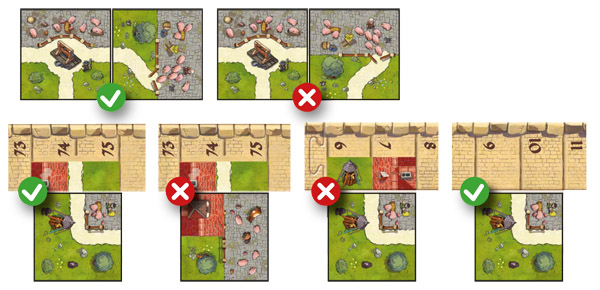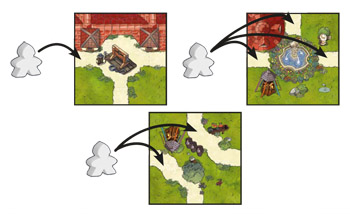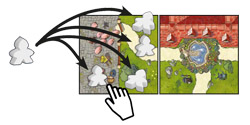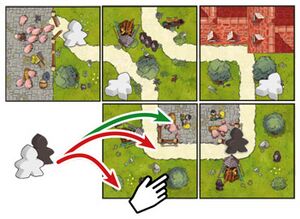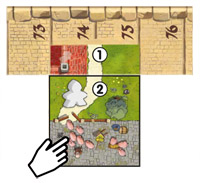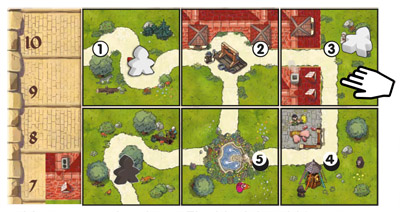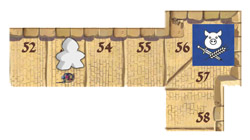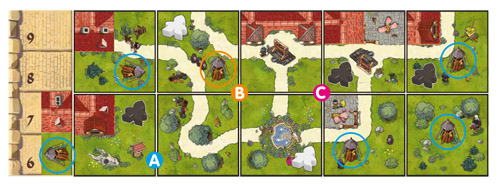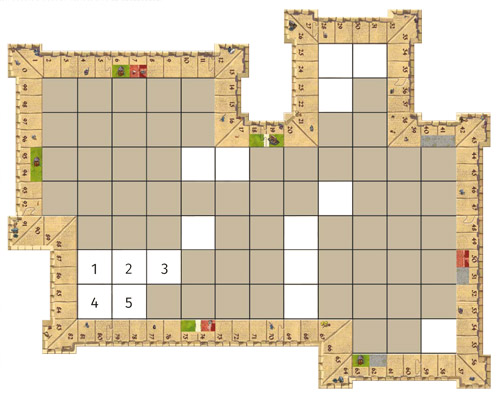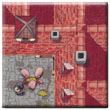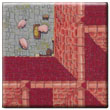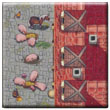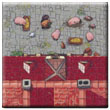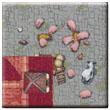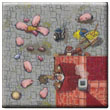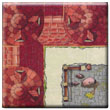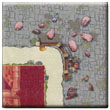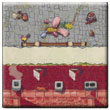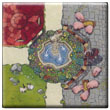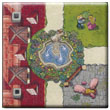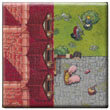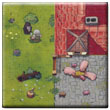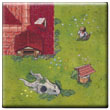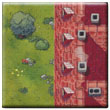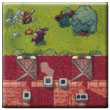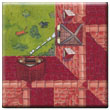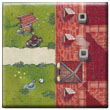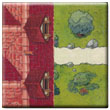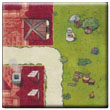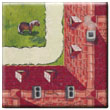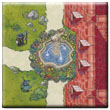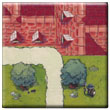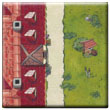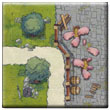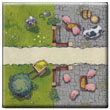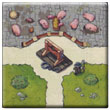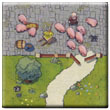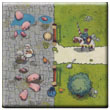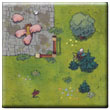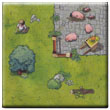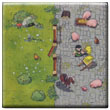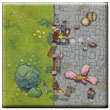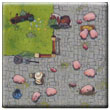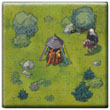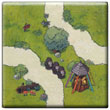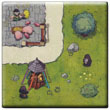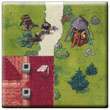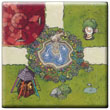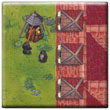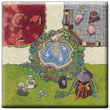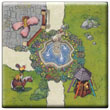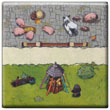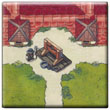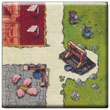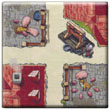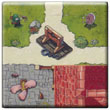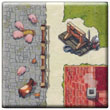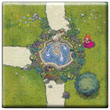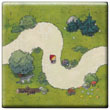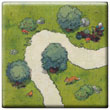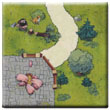Zamek: Jocul de bază
Informații generale și comentarii
Zamek a fost publicat în 2020 în poloneză de Nasza Ksiegarnia. Este o refacere completă a jocului Castelul cu stil grafic nou și unele schimbări ale lucrurilor.
Două familii concurează pentru controlul castelului în cadrul căruia se desfășoară jocul. Adăugând cartonașe, creați o rețea de drumuri, pajiști, case și cocini, asupra cărora încercați să preluați controlul. Vestitorii, călugării, scutierii și fermierii te vor ajuta să preiei controlul asupra clădirilor castelului și să câștigi puncte. Vei primi de asemenea puncte pentru două lucruri care trebuie să fie prezente în orice castel bun: sanctuare și debe. La sfârșitul jocului, persoana cu cele mai multe puncte preia controlul asupra castelului și își pune rivalul în debă.
Conținut
- 10 piese de zid de castel
- 60 cartonașe de castel
- 18 jetoane de zid (ilustrat câte unul singur dintre cele două cartonașe)
- 14 supuși în 2 culori și 2 case familiale în 2 culori
- Un abțibild ca să îți poți semna exemplarul jocului!
Schimbări de design
Următoarele sunt principalele schimbări ale lucrurilor dintre Castelul și Zamek.
- Scuarul (lucru care separa un drum în 3 drumuri distincte) este o fântână („fontanna”).
- Fântâna (lucru care face drumurile să aducă 2x per cartonaș și arată ca un puț) este o debă („dyby”).
- Turnul a fost redesenat drept cocină („chlew”).
- Curtea este redenumită în pajiște („łąka”).
- Piața, situată pe o curte, a fost înlocuită de un sanctuar sau o capelă („kapliczka”).
- Cele 2 piese donjoane au fost înlocuite de case familiale folosind un meeple „poartă” („dom”).
Obiectivul jocului
Două familii concurează pentru controlul castelului în cadrul căruia se desfășoară jocul. Adăugând cartonașe creați o rețea de drumuri, pajiști, case și cocini, asupra cărora încercați să căpătați controlul. Trebuie să te folosești în mod isteț de supușii tăi - vestitori, călugări, scutieri și fermierii - aceștia te vor ajuta să preiei controlul asupra obiectelor castelului și să câștigi puncte.
Vei primi de asemenea puncte pentru două lucruri care trebuie să fie prezente în orice castel decent: sanctuare și debe. La sfârșitul jocului, persoana cu cele mai multe puncte preia controlul asupra castelului și își pune rivalul în debă.
Pregătirea jocului
(A) Aranjează cartonașele de zid așa cum este arătat. Zidurile formează un traseu de punctaj (de la 0 până la 99). Este granița suprafeței de joc. Remarcă că câteva cartonașe de pe zid au spații de pornire.
(B) Plasează cele 18 jetoane speciale cu fața în jos pe masă și amestecă-le. Apoi plasează 1 jeton pe fiecare turn de apărare (cu excepția celor cu spațiul 0 și 1). Pune jetoanele nefolosite înapoi în cutie (fără a trage cu ochiul).
(C) Plasează 60 de cartonașe pe masă cu fața în jos și amestecă-le. Apoi fă mai multe teancuri din ele și plasează-le în afara zidurilor castelului.
(D) Ia 1 casă familială și 6 supuși de culoarea aleasă și plasează-le în fața ta.
(E) Fiecare jucător plasează 1 supus pe spațiul zero al traseului de punctaj.
Desfășurarea jocului
Jocul este început de persoana care a fost ultima la debă (sau jucătorul mai bătrân). În tura sa, un jucător poate efectua 3 acțiuni în ordinea următoare:
- Adăugarea unui cartonaș
- Plasarea unui supus în castel
- Declanșarea unei evaluări
1. Adăugarea unui cartonaș
Jucătorul ia 1 cartonaș din orice stivă și îl plasează în cadrul zidurilor în concordanță cu următoarele reguli:
- Primul cartonaș adăugat în joc trebuie să fie adiacent cu unul dintre spațiile de pornire. Aceste spații sunt tratate drept cartonașe.
- Fiecare cartonaș subsecvent trebuie să fie adiacent cu cel puțin o singură latură a oricăruia dintre spațiile de pornire sau cu alt cartonaș.
- Un drum trebuie să fie conectat de altă piesă de drum – deopotrivă cel de pe cartonașe și spațiile de pornire. Notă! Excepția este zidul. Drumul de pe cartonaș poate fi în contact cu cărămizile zidului.
- Casele, cocinile și pajiștile pot fi adăugate una la cealaltă în orice fel îți place.
- Poți adăuga orice la zid: un drum, o casă, o cocină și o pajiște.
- Cartonașele trebuie plasate cu întregile lor laturi împreună. Pot fi rotite în orice direcție.
- Dacă un jucător nu are posibilitatea de a adăuga un cartonaș, îl arată rivalului său, pune cartonașul înapoi în cutie și ia unul nou din stivă. Apoi îl adaugă pe acesta în cadrul zidurilor castelului în concordanță cu regulile descrise mai sus.
2. Plasarea unui supus în castel
Pe cartonașul tocmai plasa jucătorul are posibilitatea (dar nu este obligat) să plaseze un singur supus din rezerva sa. Dacă jucătorul nu mai are niciun supus în rezerva sa, omite această acțiune. Atunci când plasează un supus în castel, jucătorul are posibilitatea de a plasa supusul pe una dintre zonele de pe cartonașul plasat în prezent: casa, cocina, drumul sau pajiștea. În funcție de unde este plasat supusul, acesta va avea o funcție diferită.
Atunci când trimiți un călugăr pe o pajiște, culcă-l la pământ. Va zăcea acolo până la sfârșitul jocului (nu se va întoarce în rezerva jucătorului). Supușii trimiși către drumuri, case și cocini sunt plasați pe acestea. Vor rămâne acolo până ce zona pe care se află este finalizată (apoi se întorc în rezerva de supuși a jucătorilor).
Exemplu:
Un jucător adaugă un cartonaș cu o cocină, două pajiști și un drum. Pe una dintre aceste zone poate plasa un supus. Dacă ar ales una dintre cele două pajiști, ar fi trebuit să culce un supus acolo. Dacă a ales fie cocina, fie drumul, ar fi trebuit să plaseze un supus acolo.
Dacă un jucător nu are niciun supus în rezerva sa, nu trimite un supus în castel în tura sa. Totuși, atunci când un supus se întoarce în rezerva jucătorului în timpul jocului, jucătorul are posibilitatea de a îl folosi din nou.
Lupta pentru controlul asupra zonelor
Un cartonaș adăugat prelungește un drum, o casă, o cocină sau o pajiște. Dacă există deja un supus (de-al oricărui jucător), jucătorul nu poate să trimită supusul său pe acea zonă.
Ține minte, nu contează la câte cartonașe distanță este un supus care se află deja într-o zonă - controlează întreaga zonă și niciun jucător nu poate adăuga alt supus acolo.
Conectarea zonelor controlate
Un cartonaș adăugat poate face ca zone controlate de un jucător să se contopească. Dacă se întâmplă asta, jucătorul nu poate să își trimită supușii săi către zona conectată, iar supușii din zonele contopite rămân pe pozițiile lor.
Exemplu:
Jucătorul a adăugat un cartonaș cu o cocină, un drum și o pajiște.
- Jucătorul a conectat 2 drumuri controlate de jucătorul alb și jucătorul negru. Vestitorii care se află pe drum rămân pe locurile lor, iar jucătorul nu are posibilitatea de a plasa un vestitor pe cartonașul adăugat.
- Jucătorul a conectat 2 pajiști controlate de jucătorul alb. Călugării culcați pe pajiște rămân pe locurile lor, iar jucătorul nu poate plasa un călugăr pe cartonașul adăugat.
- Jucătorul de asemenea a prelungit cocina, care nu este controlată de nimeni.
Așa că jucătorul își poate trimite fermierul său acolo.
3. Declanșarea unei evaluări
Dacă cartonașul adăugat a terminat de construit un drum, o casă sau o cocină, sunt socotite punctele încasate. Terminarea construirii înseamnă că zona este închisă și nu mai poate fi extinsă mai mult. Marcați punctele încasate mutându-vă supușii pe traseul de punctaj.
Ține minte că punctele pentru zone finalizate se aplică drumului, casei și cocinii, dar nu pajiștii! Punctele pentru pajiști sunt acordate la sfârșitul jocului (acesta fiind motivul pentru care călugării stau culcați pe pajiști așteptând ca jocul să se sfârșească).
Punctele pentru o zonă finalizată sunt încasate de jucătorul cu mai mulți supuși în acea zonă. În eventualitatea unei situații de egalitate, niciun jucător nu încasează puncte.
Ține minte, nu contează care jucător adaugă cartonașul care face ca un drum, o casă sau o cocină să fie finalizat(ă). Punctele sunt încasate de jucătorul cu cei mai mulți supuși în zona închisă.
Dacă ambii jucători au încasat puncte pentru zone finalizate după ce a fost adăugat cartonașul, primul jucător care încasează puncte este jucătorul al cărui tură este. Acest lucru este important atunci când se îndepărtează jetoane de pe traseu (acest lucru va fi explicat mai târziu).
Un drum finalizat
A player with more heralds on a complete road scores 1 point for each tile on that road.
If there are stocks next to a completed road, the player receives not 1, but 2 points for each tile making up that road. More than one stock does not give any additional points! Just one stock is enough to score 2 points per road tile.
A Completed Pigsty
A player with more farmers on a completed pigsty scores 2 points for each tile that makes up that pigsty.
A Completed House
The player who has more squires on a completed house scores 1 point for each tile that makes up that house.
After scoring points for the first completed house, it becomes the family house. The player places his follower symbolizing the family house on it.
Each time a player scores a larger house (consisting of more tiles), he moves the family house there.
At the end of the game, the family house is the largest house for which a player has earned points.
Remember that once points have been awarded for a completed road, house or pigsty the followers standing on them return to their respective players. These followers can be sent back to the castle later in the game in any role: as heralds, farmers, squires or monks.
Gaining Special Tokens
The special tokens are placed on the defense towers on the castle wall (on the scoring track). Each tower covers 2 tiles on the scoring track (e.g. spaces 56 and 57). If a follower stops on one of those spaces, the player takes the special token and puts it in front of him (face up). However, if the follower passes the token space, the player does not gain a special token. [1]
Example:
To get the special token the white player must score 3 or 4 points. His follower will then stop on space 56 or 57. If he scores more and passes these spaces, he cannot take this token.
- A player may use an acquired special token on his next turn or later in the game. He may not use it immediately after capturing it.
- A player may have any number of special tokens.
- A player may use any number of special tokens during his turn.
- The used special tokens should be put back in the box.
A description of the special tokens can be found at the end of the instructions.
Player's turn ends
After the player has added the tile, placed a follower in the castle, and scored points, the player's turn ends. His opponent takes his turn.
End of game
The game ends when all the tiles in the stacks have been used.
- Put the special tokens left on the points track back in the box.
- Then the players score points for meadows and family houses (according to the rules below) – they add them to the points scored during the game.
The player with the most points scored is the winner. In case of a tie, the players share the victory.
Points for Meadows
- Consider any meadow that has at least 1 monk in it - regardless of whether the meadow is completed or not.
- A player with more monks in a meadow scores 3 points for each shrine in that meadow. He moves his follower on the score track by the appropriate number of spaces. In case of a tie, no player scores points.
Points for the Family House
- At the end of the game, there are always at least 16 empty spaces (without tiles) left within the castle walls. You count how many spaces the largest empty area occupies.
- Then you check which player has the larger family house (i.e., how many tiles the house on which the family house stands is made of).
- The player who has the larger family house scores as many points as the largest empty area. A player moves his/her pawn on the on the track by the appropriate number of spaces. In case of a tie, no player scores points.
Example:
In this case, the largest empty area has 5 tiles. The player with the larger family house therefore scores 5 points.
Description of wall tokens
Cartonașe de zid totale: 18
Ansamblul cartonașelor
Cartonașe obișnuite totale: 60
Credite
Ilustrație: Roman Kucharski
Note de subsol
Pentru licențierea și semnificația pictogramelor te rugăm să vizitezi Pagina pictogramelor.
- ↑
 Each area is scored separately, so the order in which they are scored can be important if it is possible to land on a tower segment with a wall tile with the first.
Each area is scored separately, so the order in which they are scored can be important if it is possible to land on a tower segment with a wall tile with the first.
